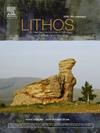地球及地球以外时空的火山/岩浆比例;岩浆在行星演化过程中到达地表的效率如何?
IF 2.9
2区 地球科学
Q2 GEOCHEMISTRY & GEOPHYSICS
引用次数: 0
摘要
随着人们对地球上多个地壳横断面的认识、高精度地质年代学的出现以及火山下地球物理成像技术的不断应用,我们现在知道,火山岩是岩浆 "热 "堡的一角,其上覆盖着一个重要的火成岩管道系统,在地壳中留下了多种类型的柱状岩石。特定岩浆岩带中火山岩与柱状岩的比例(V/P 比例)在空间和时间上都有变化,这是受构造环境、岩浆岩带的地质年代、岩浆活动持续时间、地壳流变学、岩浆物理性质和岩浆储层状态等参数控制的函数。本文旨在探讨这些不同的参数,以便更好地确定 V/P 比值在行星地壳演化过程中如何在空间和时间上演变。我们特别强调,地壳岩浆库中相分离(尤其是晶体/熔体分离)的效率是控制 V/P 比值的关键因素,是火成岩分异和地壳形成的基础。这种效率反过来又取决于岩浆通量("地幔生产力")和化学成分(包括挥发物含量)等参数,以及多相岩浆及其地壳容器的机械特性。将岩浆库与其周围壁岩结合起来的热力学建模工具的出现,为更定量地了解控制岩浆穿越行星地壳的命运的基本过程铺平了道路。本文章由计算机程序翻译,如有差异,请以英文原文为准。
The volcanic/plutonic ratio in space and time, on Earth and beyond; How efficiently do magmas reach the surface during planetary evolution?
With the recognition of multiple crustal cross sections on our planet, the advent of high-precision geochronology, and the ever-increasing application of geophysical imaging beneath volcanoes, we now know that volcanic rocks are the tip of a magmatic “heat”berg, overlying a significant igneous plumbing system that leaves many types of plutonic rocks in the crust. The ratio of volcanic to plutonic rocks in a given magmatic province (the V/P ratio) varies in space and in time as a function of several parameters controlled by the tectonic setting, geological age of the magmatic province, duration of magmatic activity, rheology of the crust, physical properties of the magma and state of the magma reservoirs. This contribution intends to explore these different parameters, in order to better constrain how the V/P ratios evolve in space and time in the course of planetary crust evolution. In particular, we stress that the efficiency of phase separation (in particular crystal / melt separation) in crustal magma reservoirs, fundamental to igneous differentiation and crust formation, is a key factor in controlling the V/P ratios. This efficiency, in turns, depends on parameters such as magma fluxes (“mantle productivity”) and chemical compositions (including volatile content), as well as the mechanical properties of the multi-phase magma and of its the crustal container. The emergence of thermo-mechanical modeling tools coupling the magma reservoir with its surrounding wall-rocks is paving the way to a more quantitative understanding of the fundamental processes that control the fate of magmas traversing through planetary crusts.
求助全文
通过发布文献求助,成功后即可免费获取论文全文。
去求助
来源期刊

Lithos
地学-地球化学与地球物理
CiteScore
6.80
自引率
11.40%
发文量
286
审稿时长
3.5 months
期刊介绍:
Lithos publishes original research papers on the petrology, geochemistry and petrogenesis of igneous and metamorphic rocks. Papers on mineralogy/mineral physics related to petrology and petrogenetic problems are also welcomed.
 求助内容:
求助内容: 应助结果提醒方式:
应助结果提醒方式:


